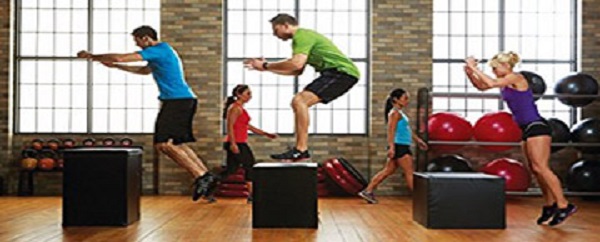Guide To Plyometric Exercise

‘Plyometric’ is a term used to describe explosive, jumping type exercises e.g. squat jumps, skaters, clapping press ups, etc. Research suggests that plyometric exercise can be a significant factor in reducing risk of running related injury. Let’s take a look…
The Stretch Shortening Cycle
Running can essentially be seen as an extended series of hops from one leg to the other: 1,951 if you run a mile at 12-minute pace, 1,064 at a 6 minute pace. That’s a lot of hopping, especially when we consider the forces that our body has to deal with every time we land. Fortunately, we are gifted with an ingenious biomechanical system that not only absorbs the impact each time we land but also converts it into energy for forward propulsion.
Imagine pushing down on a spring: as it bends and coils it stores the energy you are applying (referred to as elastic strain energy); when you let go it releases the energy. Muscles and in particular tendons are thought to act in a similar way to springs. When our foot lands, the bending (flexing) ankle & knee joints store elastic energy; as our body passes over the weight bearing foot the knee, ankle and hip all straighten (extend) and use the stored energy to help propel our body forwards and upwards.
This concept of a lengthening of the muscle-tendon unit followed by a shortening is referred to as the Stretch-Shortening Cycle (SSC) and is characterised by three stages (see below). Training the body to make the most of the stretch-shortening cycle is the basis of plyometric exercise:
- Landing Phase – eccentric contraction of muscle for absorption and storing of energy
- Amortization Phase – minimum turnaround time between landing and take off
- Take-off Phase – contraction of muscle for release of stored elastic energy and propulsion.
History Of Plyometrics
Yuri Verkhoshansky was one of the USSR’s leading biomechanists & sports trainers in the 1970’s working extensively with the Soviet national sports teams for the Olympic Games and is credited with developing the stretch-shortening concept of muscle contractions. In 1975, USA Olympic long-distance runner Fred Wilt was watching athletes from the Soviet Union perform jumps in their warm-ups prior to their event in track and field.
To describe them, Wilt coined the phrase ‘plyometric’ and after consulting with performance coach & researcher Dr. Michael Yessis, Wilt discovered that the jumps were based on research being pursued by Verkhoshansky, called his ‘Shock Method’ of training.
Centred on the concept of the stretch-shortening cycle, Verkhoshansky’s had been developing exercises such as his signature ‘depth jump’ which aimed to optimise conversion of the forced, involuntary eccentric contraction of a “shock” landing, e.g. an athlete jumping off a box, into an immediate concentric contraction, e.g. the athlete immediately jumping upwards after landing.
According to his studies, this replicated the ground force actions that occur in running and jumping, duplicating the forces required in landing and takeoff. Given the often exceptional performance of Soviet athletes in the 60’s and 70’s, Dr. Yessis went on to visit and work with Verkhoshansky in 1980’s and published translations of much Soviet science-based sports research. In doing so, ‘plyometrics’ was introduced to the rest of the world.
“Imagine pushing down on a spring: as it bends and coils it stores the energy you are applying; when you let go it releases the energy. Muscles and tendons are thought to act in a similar way.”
Modern Day Plyometrics
Today, the term plyometrics is often used to describe any explosive jump, regardless of the time difference between landing and takeoff. Though there will still be strength benefits from performing say a deep squat followed by an explosive jump, in terms of specific training for shorter distance running like sprinting it may be useful to recall Verkhoshansky’s principles. Test it yourself – which gives you a more powerful, higher jump: a deep squat or a very quick knee bend?
Distance running does not of course share the same demand for explosive type muscular contractions as sprinting so it may be wiser to avoid potential injury and focus on simpler jumping exercises of 20 to 30 consecutive jumps. Though explosive reactive jumps with minimum ground contact time can still be practised, there need not be as much the focus on ‘shock’ landing and timing as is expected in depth jumps and other pure plyometric exercises.
Plyometrics For Distance Runners
The joy of plyometric exercises for distance runners is that you can potentially get good results without the need for huge time expenditure. For runners who are unlikely to fit regular ancillary sessions of strength & conditioning into their week, one option may be to include a few plyometric exercises in the latter part of the dynamic warm up. The consistency of performing a little every week will be safer than sporadically surprising your body with a sudden hour of effort once a month.
One study (Paavolainen et al., 1999) on well trained endurance athletes found that replacing just one-third of their normal running with plyometrics improved their 5k race times. The 18 runners in the study underwent the same total training volume over a nine week period but 10 of them had 32% of the running replaced with plyometric training. Following the nine weeks, the 5K time of these 10 runners improved whereas no changes were observed in the other 8.
Here are a selection of popular plyometric exercises:
- Squat Jumps
With feet shoulder width apart, jump as high as possible off both feet; land in a slight squat and with minimal ground contact time repeat up to 20 times. - Tuck Jumps
The same as the squat jump but as you jump bring the knees as high as possible. Remain upright and avoid bending forwards from the waist. - Lunge Jumps
From a slight lunge (with body weight equal distance between feet) jump as high as possible; in mid air, reverse the positions of the legs and land; with minimal ground contact time repeat up to 20 times. - Side Hops
Stand on your left foot with your left knee slightly bent and your right foot elevated; jump as high as you can and land on the right foot; with minimal ground contact time repeat up to 20 times. - Turning Hops
The same as the side hops but aim to perform a quarter turn in mid air. This can be progressed over time to a half turn (land facing the opposite direction) or even a 180o turn. To avoid dizziness, adjust the direction and number of reps accordingly. - Bounding
A popular run specific drill, bounding is essentially an exaggerated skipping motion focussing on a powerful leap into the air, holding the arms in a fixed position during the moment both feet are off the ground.
A Word Of Caution
It is important to remember that plyometric exercises are tough on the body and require a base level of general strength. Before embarking on the above exercises, you should ensure you have completed a six to eight week program of graded, basic lift strength training. Once you have completed this and seen strength gains, bear in mind that even competitive runners choose not to do plyometric exercise all year round. Instead, they tend to include them in the race specific portion of training, 4-6 weeks before competition.
With the caution taken on board, research supports the fact that a 5-10 minute plyometric circuit routine once a week or a couple of plyometric exercises at the end of your warm up may well help you reduce injury risk and improve performance. You will of course need to be warmed up first, and the number of reps you choose will depend on personal fitness level. As with any form of new exercise, if in any doubt consult an exercise professional for advice.
Have you had any experience with plyometric exercise? Maybe you did too much too soon and paid the consequences? Maybe you added some to your weekly training and saw some great benefits? Either way we would love to hear from you so feel free to share your thoughts in the comments section below!


0 Comments